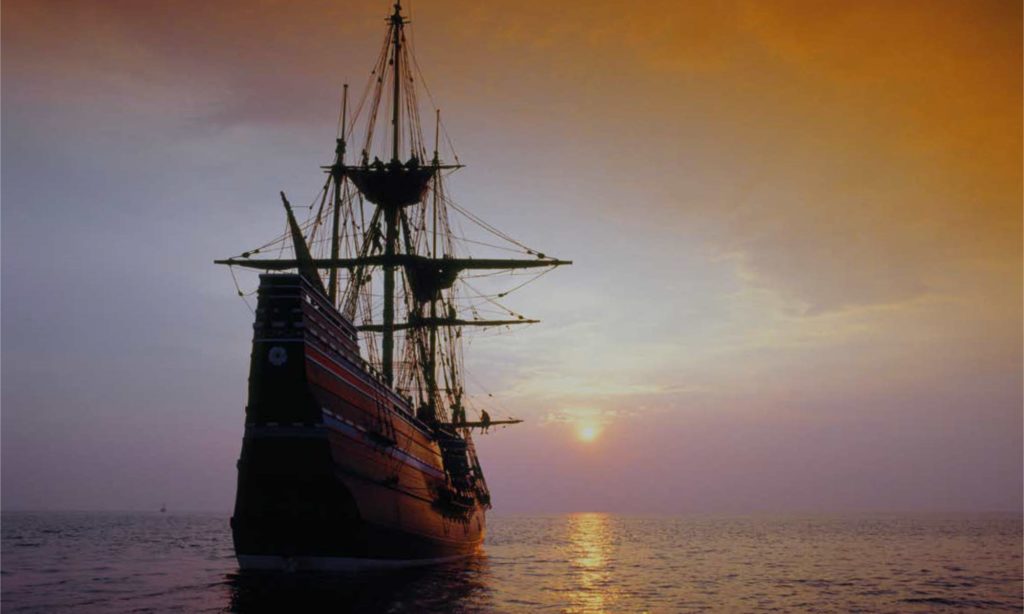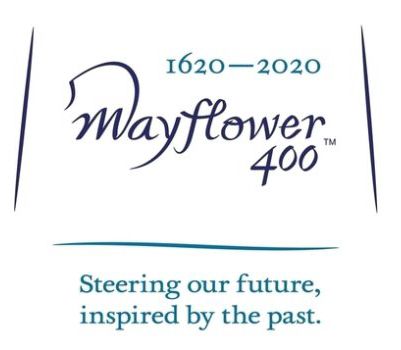#Mayflower400: Leiden chooses side of the coloniser

In 2020, the journey of the Pilgrims from Leiden, via England, to America will be commemorated under the name “Mayflower 400“. This marks 400 years since the Pilgrims traveled on the fabled “Mayflower” ship. The official narrative is a story of jubilation and success and the two key words of the Leiden commemoration are “Freedom and Tolerance”. This theme year was initiated by Leiden Marketing, which is trying to strengthen and add interest to the Leiden “brand”. What will happen during the commemoration year, what is the story being presented, and who will benefit from the commemoration?
The organizing committee of Mayflower 400 organized a conference (pdf) in October 2018 with “partners” in the city that are enthusiastic for the commemoration year. The conference guide that was circulated had four objectives: “sustainable development of heritage tourism from the US, developing relationships between Dutch, English and American institutions, promoting Leiden as a city of freedom and tolerance, and development of a business acquisition strategy”. These goals clearly show that the entire project has little to do with history and everything to do with city promotion and regionalism. The Leiden brand must stand out in the minds of US tourists, institutions and businesses. The fictional and mythical image of the Pilgrims is being used in an attempt to paint a corresponding fictional and mythical image of Leiden. And of course, criticism does not fit with this agenda.
There is an extensive program planned for the commemoration year. Events include a walking tour through Leiden, exhibitions in the Museum of Ethnology and the Lakenhal Museum, a lecture series at Leiden University, and theater performances. Some program components are quite far-fetched, such as one professing a link between the Leiden Marathon and the Boston Marathon. There are additional projects that are linked to the Pilgrim year in a rather forced way. The majority of the projects make no link whatsoever with colonialism, and the original inhabitants of America remain virtually unnamed. It is also striking how often a link is made between the Pilgrims then and the refugees now, such as in the “We Are Leiden” project and the “Modern Pilgrims” photo project. More about that below.
This text was translated by Lucinda Juliani. Here’s the original text in Dutch.
Racism and “Terra Nullius”
Racism toward American Indians is as old as European colonialism.(1) From the start, Indians were portrayed by Europeans as wild, uncivilized and undeveloped. The Indians were almost seen as part of American nature. America was thought of as empty and available for Europeans. At most, the Indians had to convert to Christianity. This perspective was used as justification for stealing, colonizing, and looting Indian country and destroying Indian culture. The myth that America was undeveloped and uninhabited, and that the land could be taken over by “civilized” white Christian Europeans, is called the “terra nullius” myth.
Apart from this being an inherently racist image of superior and inferior cultures, it is also complete nonsense. America was already inhabited when large parts of Europe were still under the ice caps of the last ice age. (2) Talk about “old” and “new” land! Complex cultures have been around much longer in the Americas than in Europe. Even at the time of Columbus, the enormous empires of the Aztecs and Incas were no less than those in Europe, and the population of the Americas was larger than that of Europe. North American Indians managed the landscape on an immense scale: they burned off parts of forests that were replaced by grasslands. The grasslands supported large grazing animals that provided a generous food supply. The Native Americans were in fact cattle farmers on a continental scale, a form of animal husbandry that was not yet recognized by Europeans.
Inclusiveness
The racial “terra nullius” myth is also being furthered by the organization designing and promoting the Mayflower memorial year. For example, on the front page of the website of the commemorative year, America and the original American cultures are reduced to “the undeveloped American wilderness”. Nothing is said about the America that already existed or its inhabitants, and the presence of Native Americans is erased from this colonial historiography.
However, the organization claims that it is an “inclusive” commemoration (see the tweet below). What exactly is meant by that remains rather unclear. As far as we are concerned, people are already misguided based on the very focus of the year: the colonizer and not the colonized ones. Yes, the Pilgrims were religious refugees, but they were also colonizers. And the very fact that they were colonists has made them famous and a symbol of the United States. It is precisely the descendants of those settlers that Leiden tries to lure into coming to the city. So it is enormously hypocritical to celebrate and amplify that colonist and adventurer sentiment, but then to completely ignore the consequences of that colonialism, then and now.
The Pilgrims city walk guide also contains no reference to the original Americans. The only event that seems to be dedicated to Native Americans is an exhibition at Museum Volkenkunde: “Native Nations in the 17th Century”. But with just such an exhibition, the commemoration can not be called “inclusive”. Inclusivity is something other than “illuminating all sides”, inclusiveness means taking the ideas and position of oppressed groups seriously, and the organization of the memorial does not.
Refugees and “Relevance Now”
As religious refugees, the Pilgrims are also being pushed into a kind of underdog role that is meant to arouse sympathy. It is awkward and problematic when the Pilgrims, white settlers who left for America with the support of money lenders, are equated with refugees of today in the Mediterranean. Their position, social status, and role in history are so immensely different that it is disingenuous to compare both groups without a tremendous amount of context and illumination.
In the conference guide it says: “The story of the Pilgrims raises interesting questions that also apply here and now, for example with regard to migrant flows in the Mediterranean and the Mexican border, and the current social position of the original inhabitants from America. The international commemoration is a good opportunity to relate the ever-relevant theme of migration, tolerance and oppression to the present and to inspire current and future generations with this rich and ever-relevant history.”
We do have some interesting questions that apply to the here and now. For example: what was the Pilgrims’ role in colonialism, and how does colonialism continue to work? How does that affect the creation of migration flows in Mexico and the Mediterranean? How does that affect the position of Native Americans now? How did they fight and how do they still fight against colonial oppression, the basis of which was in part laid by the Pilgrims?
Self-criticism
The municipality of Leiden and Leiden Marketing could benefit from a dose of insight and self-criticism. They would like to believe that the fact that the Pilgrims were so welcome in Leiden as refugees created a paradigm, and this theme was extensively exploited years ago when Leiden was given the “City of refugees” brand. But what does Leiden actually do for refugees? Do people take a stand against the prevailing policy of migration control, and do they stand up for free migration? Are all refugees taken care of unconditionally? The answer will not surprise: no. Lots of talks and symbolism, few acts that really benefit refugees now.
Leiden should also look at itself and the role of the Netherlands in other areas. In the seventeenth century the Netherlands had a colony in a region nearby to where the Pilgrims landed: New Amsterdam (now New York). If the story of the Pilgrims is deepened, it is only logical to also look at the role and influence of the Netherlands in North America, and at the Dutch role in colonialism as a whole.

Freedom and tolerance
For many Native Americans, the Pilgrims symbolize the beginning of the genocide on their ancestors. Their arrival is often seen as the beginning of a period of suppression of their culture that continues to this day, and which is being fought to this day. Thanksgiving, the holiday that is celebrated each November in the US and which, according to the story, refers to a celebration of the Pilgrims and the Wampanoag (who lived in the area where the Pilgrims came ashore), is not celebrated by Indians. Instead, they hold a Day of Mourning on that day.
The Pilgrims also symbolize the nationalist historiography of the US and the idea of “manifest destiny;” the idea that European “civilization” is superior and that European settlers were destined to colonize the whole of America. This idea continues to this day among white residents of the US and is intertwined with national historiography. This denies the foundations of the history of the US, a country built on stolen land. A country whose native population has been largely eradicated, and where their surviving descendants are still being actively suppressed.
Upon deeper research, the “heroes” of this national historiography appear, unsurprisingly, to not have been such angels, just as is the case with Dutch colonial “heroes”. And just as the Netherlands still has to come to terms with its bloody and destructive colonial history, so too does the US. In the Netherlands, there is hard fighting from the ground up for the decolonization of historiography, education and the street scene. And that struggle is starting to bear fruit: more and more governments, companies and museums feel compelled to begin with this, though their efforts are still inadequate. In the US, this grassroots struggle is being pursued just as passionately. With these efforts in mind, it is exceedingly disappointing that Leiden unquestioningly chooses the side of the colonizer with the Pilgrims project.
Taking this all into consideration, it is ironic that the municipality of Leiden is designing a theme year of “tolerance and freedom” around these Pilgrims. Whose freedom is it? And tolerance of who towards whom? Which stories do Leiden city marketeers want to hear and which do they ignore?
If Leiden really wants to be a city of “tolerance and freedom”, it is advisable to take the voices of oppressed groups seriously. By receiving refugees, for example, by abolishing Black Pete, by giving the extreme right no room, by ending the commemoration of soldiers who fought against the independence of Indonesians. By no longer placing the colonizer on a pedestal, but instead those who fought against colonialism. By opting for decolonization instead of concealing genocide, murder and looting.
Doorbraak
Notes:
- See: “The Invasion of America” by Francis Jennings.
- See: “1491” by Charles Mann.
Onze artikelen over #mayflower400
1. Kritiek op het Pilgrim-herdenkingsjaar in Leiden (overzicht)
2. Enkele kritische vragen bij de Pilgrim-citymarketing in Leiden (Tweets)
3. #Mayflower400: Leiden kiest de kant van de kolonisator
4. Teken ook de open brief: “Delfshaven400/Pilgrim Harbour is geschiedvervalsing van het Nederlandse kolonialisme”
5. Lakenhal-expositie zet koloniale christenfundamentalistische Pilgrims in het zonnetje
Our articles on #mayflower400
1. Criticism on the Mayflower400 commemoration year in Leiden
2. #Mayflower400: Leiden chooses side of the coloniser
3. Leiden Pilgrim commemoration changes, but is still colonial
4. Letter to Delfshaven400: “You can’t commemmorate the Pilgrims without reference to colonisation”
